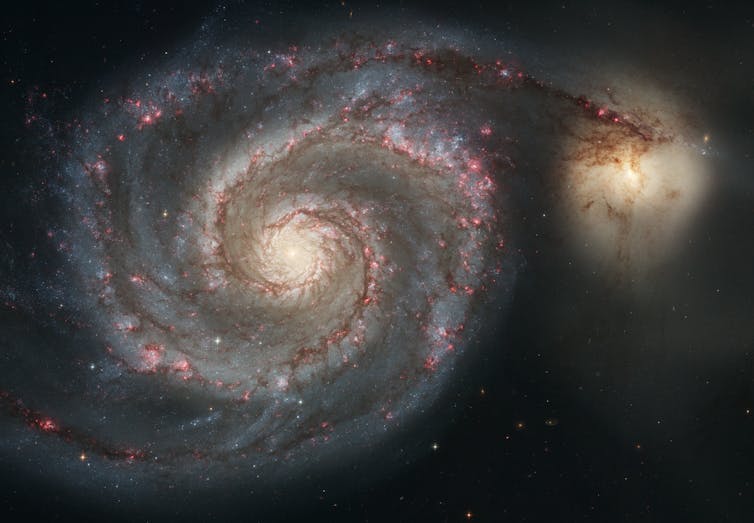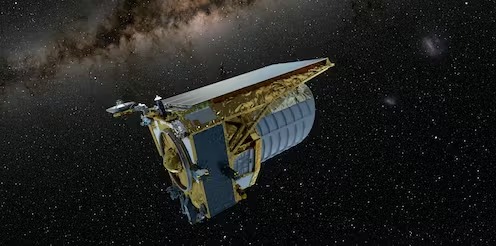The European Space Agency’s (ESA) Euclid satellite completed the first part of its long journey into space on May 1 2023, when it arrived in Florida on a boat from Italy. It is scheduled to lift off on a Falcon 9 rocket, built by SpaceX, from Cape Canaveral in early July.
Euclid is designed to provide us with a better understanding of the “mysterious” components of our universe, known as dark matter and dark energy.
Unlike the normal matter we experience here on Earth, dark matter neither reflects nor emits light. It binds galaxies together and is thought to make up about 80% of all the mass in the universe. We’ve known about it for a century, but its true nature remains an enigma.
Dark energy is similarly puzzling. Astronomers have shown that the expansion of the universe over the last five billion years has been accelerating faster than expected. Many believe this acceleration is driven by an unseen force, which has been dubbed dark energy. This makes up about 70% of the energy in the universe.
Euclid will map this “dark universe”, using a suite of scientific instruments to shed light on different aspects of dark energy and dark matter.
A light in the dark
After launch, Euclid will undertake a month-long journey to a region in space called the second Earth-Sun Lagrangian point, which is five times further from us than the Moon. It’s where the gravitational pull of the Sun and the Earth balance out and provides a stable vantage point for Euclid to observe the universe. Euclid will join the James Webb Space Telescope (JWST) at this point and will be the perfect companion to that amazing space observatory.
My involvement in Euclid began in 2007 when I was invited by ESA to participate in an independent concept advisory team to assess two competing mission proposals called SPACE and DUNE.
Both used different techniques, and therefore different instruments, to study the dark universe, and ESA was struggling to decide between them. Both were compelling concepts and our team decided that both had merit, especially to provide a vital cross-check between them. Euclid was thus born from the best of both concepts.
Euclid is designed to study the whole universe so needs instruments with wide fields of view. The wider the field of view of the imaging instrument, the more of the universe it can observe. To do this, Euclid uses a relatively small telescope compared to JWST. In size, Euclid is roughly the size of a truck compared to the aircraft-sized JWST. But Euclid also carries some of the biggest digital cameras deployed in space with fields of view hundreds of times greater than JWST’s.
Shapes and colours
The Euclid VIS (or visible) instrument, built mostly in the UK, is designed to measure the positions and shapes of as many galaxies as possible to look for subtle correlations in this data caused by the gravitational lensing of the light, as it travels to us through the intervening dark matter. This gravitational lensing effect is weak, only one part in a hundred thousand for most galaxies, thus requiring lots of galaxies to see the effect in high definition. Thus VIS will produce Hubble telescope-like image quality over a third of the night sky.
VIS, however, can’t measure the colours of objects. This is needed to measure their distance through the redshift effect, where light from those objects is shifted to longer, or redder, wavelengths in a way that relates to their distance from us. Some of this data will need to come from existing and planned ground-based observatories, but Euclid also carries the NISP (Near-Infra Spectrometer and Photometer) instrument which is specifically designed to measure the infrared colours and spectra, and therefore redshifts, for the most distant galaxies that Euclid will see.
To measure dark energy, NISP will exploit a relative new technique called Baryon Acoustic Oscillations (BAO) that provides an accurate measurement of the expansion history of the universe over its last 10 billion years. That history is vital for testing possible models of dark energy including suggested modifications to Einstien’s Theory of General Relativity.

Euclid will gather information on the shapes and other properties of galaxies in the sky. NASA, ESA, S. Beckwith (STScI), and The Hubble Heritage Team (STScI/AURA), CC BY
Treasure trove
Such an experiment takes an army of scientists and not everyone is solely working on dark matter and dark energy. Like JWST, Euclid will be a treasure-trove of new discoveries in many areas of astronomy. The Euclid consortium needs hundreds of people to help develop the sophisticated software needed to merge the space data with the ground-based data, and extract, to high accuracy, the shapes and colours of billions of galaxies.
This software has also been checked and verified using some of the largest simulations of the universe that have ever been constructed. After arriving at L2, Euclid will undergo several months of testing, validation and calibration to ensure the instruments and telescope are working as expected. We are all familiar with such nervous waiting after the recent JWST launch.
Once ready, Euclid will embark on a five-year survey of 15,000 square degrees of the sky with about 2,000 scientists from across the world collecting results along the way. However, the true power of Euclid will only be realised once we have all this data together and analysed carefully. That could take another five years, taking us well into next decade before we have our final dark answers. The SpaceX launch therefore only feels like the half-way point in the Euclid story.
I will travel to Florida this summer to see the launch of Euclid. I will be joined by hundreds of my colleagues who have dedicated their careers to building this amazing telescope and experiment. Seeing the project come together in this way makes me proud to call myself a “Euclidian”.



 CDC Vaccine Review Sparks Controversy Over Thimerosal Study Citation
CDC Vaccine Review Sparks Controversy Over Thimerosal Study Citation  Astronomers have discovered another puzzling interstellar object − this third one is big, bright and fast
Astronomers have discovered another puzzling interstellar object − this third one is big, bright and fast  Senate Sets December 8 Vote on Trump’s NASA Nominee Jared Isaacman
Senate Sets December 8 Vote on Trump’s NASA Nominee Jared Isaacman  Lost in space: MethaneSat failed just as NZ was to take over mission control – here’s what we need to know now
Lost in space: MethaneSat failed just as NZ was to take over mission control – here’s what we need to know now  Is space worth the cost? Accounting experts say its value can’t be found in spreadsheets
Is space worth the cost? Accounting experts say its value can’t be found in spreadsheets  Neuralink Expands Brain Implant Trials with 12 Global Patients
Neuralink Expands Brain Implant Trials with 12 Global Patients  NASA Astronauts Wilmore and Williams Recover After Boeing Starliner Delay
NASA Astronauts Wilmore and Williams Recover After Boeing Starliner Delay  SpaceX Starship Explodes in Texas During Test, Citing Nitrogen Tank Failure
SpaceX Starship Explodes in Texas During Test, Citing Nitrogen Tank Failure  Eli Lilly’s Inluriyo Gains FDA Approval for Advanced Breast Cancer Treatment
Eli Lilly’s Inluriyo Gains FDA Approval for Advanced Breast Cancer Treatment  Ancient Mars may have had a carbon cycle − a new study suggests the red planet may have once been warmer, wetter and more favorable for life
Ancient Mars may have had a carbon cycle − a new study suggests the red planet may have once been warmer, wetter and more favorable for life  FDA Lifts REMS Requirement for CAR-T Cell Cancer Therapies
FDA Lifts REMS Requirement for CAR-T Cell Cancer Therapies  Lab-grown meat: you may find it icky, but it could drive forward medical research
Lab-grown meat: you may find it icky, but it could drive forward medical research 































